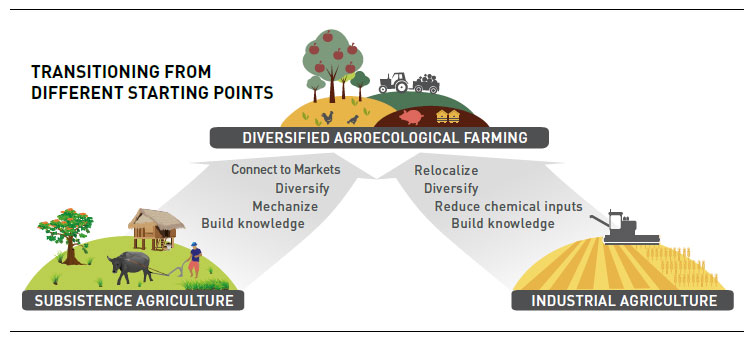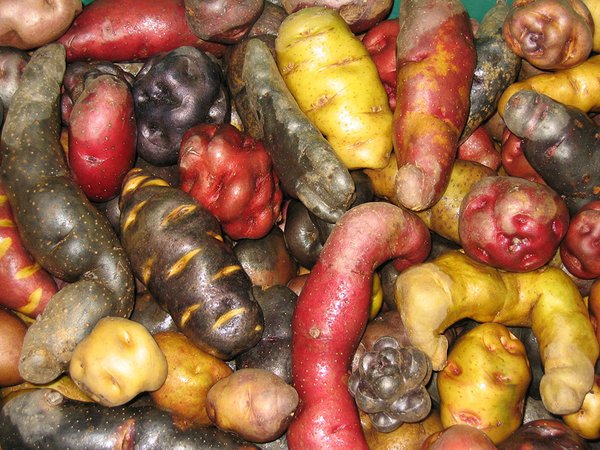 Read this article in French
Read this article in French
 Download this article in magazine layout
Download this article in magazine layout
- Share this article
- Subscribe to our newsletter
Food system transformation starts and ends with diversity
If the food system transformation we need could be summed up in a single word, it would be diversity. We need diversity in the field, within the farm, across the landscape, and throughout the economy. We need soil biodiversity, agrobiodiversity, wild biodiversity and dietary diversity. We need to value diverse forms of knowledge – or as Vandana Shiva put it, we must move beyond ‘monocultures of the mind’. In some ways, it is a journey back to the diversity that characterised agro-ecosystems prior to the advent of industrial agriculture. In other ways, it is a journey forward, drawing on cutting-edge knowledge to deliver highly productive, resilient, resource-efficient and multifunctional landscapes.
Industrial agriculture – an existential threat to itself?
The challenges we face require no less. COVID-19 has affected one third of food and farming livelihoods. It has added 100 million people to the world’s hungry – who already numbered 750 million before the pandemic. In addition, two billion people suffer from micronutrient deficiencies and 1.9 billion are obese or overweight. Around the world, those facing poverty and malnutrition are often small-scale farming communities.
The environmental picture is bleaker still. More than half of the world’s farmland is degraded or severely degraded, and every year an area the size of the Philippines’ cultivated land is added to the list. Runoff from fertiliser is polluting groundwater and causing vast dead zones in estuaries. Over-use of antibiotics in industrial feedlots is accelerating the spread of antibiotic resistance – predicted to be a bigger killer than chronic diseases by mid-century. Food systems are responsible for as much as one third of global greenhouse gas emissions.
Perhaps most alarmingly of all, agriculture is responsible for 80 per cent of deforestation and 70 per cent of terrestrial biodiversity loss. Instead of nurturing the biodiversity it relies on to thrive, agriculture is helping to destroy it – and is therefore an existential threat to itself.
How uniformity took over the world
It is worth recalling how we got here. Throughout history, humans have consumed over 7,000 species of plants as well as numerous animal species, most of them harvested from the wild. Over the last 10,000 years, a significant number of species have been domesticated and were part of diverse agricultural systems. But the 20th century saw a major reorganisation of production systems. As the ‘Green Revolution’ took hold around 50 years ago, food production systems were increasingly focused on a small number of staple crop varieties and animal breeds. They were designed for production in uniform, intensive, and highly-specialised systems. Rather than relying on diversity to keep soils healthy and mitigate risks, they opted for synthetic fertilisers, pesticides and antibiotics. While industrial food systems increased production, they have left a legacy of soil degradation, water and air pollution, greenhouse gas emissions and drastic biodiversity losses – while failing to end hunger and malnutrition.
Time for a transformation
Over the last decade, it has become increasingly clear that this trajectory is not sustainable. A profound transformation – a new paradigm – is urgently needed. This is the conclusion of landmark reports from the Intergovernmental Panel on Climate Change, the Intergovernmental Science-Policy Platform on Biodiversity and Ecosystem Services, the High Level Panel on Food Security and Nutrition, and many others. Diversity is front and centre of these calls for food system transformation. This reflects the growing evidence from around the world of what diversity can achieve, from the soil microbiome to the plate:
- Soil biodiversity, including a wide diversity of microbes, arthropods and earthworms, is key to achieving healthy and productive soils via nitrogen fixation, nutrient mobilisation, organic matter decomposition and transformation in humus, soil texture improvement facilitating root penetration, water retention and carbon sequestration.
- Combining different species with different roots systems and nutritional requirements enables a better exploitation of soil nutrients and water and can take advantage of synergies, such as the combination of leguminous species and cereals in which the leguminous species fix more nitrogen than if grown in pure stands.
- Diverse mixed plant-animal farming and agroecological practices, such as legume intercropping and permanent soil cover, increase soil biodiversity and allow synthetic fertilisers to be replaced with locally-sourced organic fertilisers.
- A broad range of pollinating insects are necessary for food production. Almost 75 per cent of the world’s crops producing fruits, vegetables and seeds for human consumption depend, at least in part, on pollinators for sustained production, yield and quality. Other parasitic or predatory insects as well as birds contribute to pest control.
- Diverse fields and landscapes, combined with agroecological practices, re-establish natural pest and disease control systems that do not require pesticides. The use of complementary species in and around fields, such as in push-pull systems, allow for pest and weed management.
- Diversified production systems provide for healthy, diverse diets. The reintroduction of neglected and underutilised species – especially those rich in vitamins, minerals, health-giving antioxidants and polyphenols, and other micronutrients – helps to re-diversify diets and improve the quality of nutrition in farming communities and beyond.
- Diversification of production systems also diversifies sources of livelihood and builds resilience to shocks. Firstly, it decreases the vulnerability of farming households to commodity price volatility. Secondly, it also allows workload to be spread throughout the year and provides more stable employment. And thirdly, diverse production systems are more resilient to extreme weather events. For example, after Hurricane Mitch in 1998, the diverse fields of small-scale peasants in Honduras recovered much faster from the damage than the monoculture banana fields neighbouring them. And when Hurricane Ike hit Cuba in 2008, the losses on diversified farms were only half as bad as on neighbouring monocultures.
These approaches are mutually reinforcing. Diversity in the field breeds diversity in the ecosystems and landscapes surrounding them. There is a close correlation between the diversity of plants and the diversity and abundance of the soil microbiome and fauna. Re-introducing more biodiversity in landscapes, e.g. incorporating tree crops and other perennials, also brings back wild biodiversity in them.

A unifying framework for food system transformation, with diversity at its core
Different terminologies are used to describe the transformation we need. But there is growing consensus that production systems must be redesigned and re-rooted in diversity. These approaches are captured in the 13 Principles of agroecological transformation (see Box) identified by the High Level Panel on Food Security and Nutrition in 2019, building on the ten elements of agroecology previously adopted by the UN Food and Agriculture Organization (FAO). These principles can address all situations and all scales, but their practical application is location-specific and involves continuous co-innovation between farmers and scientists. These principles provide a unifying framework for all of those redesigning and re-diversifying their farming systems, whether they refer to themselves as agroecological, regenerative, organic, or permacultural.
Policymakers looking for ‘win-win-wins’ – for social, environmental and economic sustainability, or for animals, people and the planet – should look no further than diversified agroecological systems. This is the comprehensive response to industrial agriculture, and the way out of its vicious cycles. The benefits for biodiversity are obvious, but the potential for tackling climate change is no less dramatic: the combination of carbon sequestration in soils and diverse vegetation, including trees, has the potential to transform our food systems from being the greatest greenhouse gas emitter to being carbon neutral. Indeed, diversified agroecological systems will deliver on virtually all of the Sustainable Development Goals (SDGs), and we must transition towards them, irrespective of whether the starting point is under-performing subsistence agriculture or unsustainable industrial agriculture.
In other words, it is time to stop seeing biodiversity as a necessary victim of food systems. Food system transformation starts and ends with diversity – and the time for transformation is now.
PRINCIPLES TO GUIDE AGRICULTURE AND FOOD SYSTEMS TRANSFORMATION
1. Recycling. Preferentially use local renewable resources and close as far as possible resource cycles of nutrients and biomass.
2. Input reduction. Reduce or eliminate dependency on purchased inputs and increase self-sufficiency.
3. Soil health. Secure and enhance soil health and functioning for improved plant growth, particularly by managing organic matter and enhancing soil biological activity.
4. Animal health. Ensure animal health and welfare.
5. Biodiversity. Maintain and enhance diversity of species, functional diversity and genetic resources and thereby maintain overall agroecosystem biodiversity in time and space at field, farm and landscape scales.
6. Synergy. Enhance positive ecological interaction, synergy, integration and complementarity among the elements of agroecosystems (animals, crops, trees, soil and water).
7. Economic diversification. Diversify on-farm incomes by ensuring that small-scale farmers have greater financial independence and value addition opportunities while enabling them to respond to demand from consumers.
8. Co-creation of knowledge. Enhance co-creation and horizontal sharing of knowledge including local and scientific innovation, especially through farmer-to-farmer exchange.
9. Social values and diets. Build food systems based on the culture, identity, tradition, social and gender equity of local communities that provide healthy, diversified, seasonally and culturally appropriate diets.
10. Fairness. Support dignified and robust livelihoods for all actors engaged in food systems, especially small-scale food producers, based on fair trade, fair employment and fair treatment of intellectual property rights.
11. Connectivity. Ensure proximity and confidence between producers and consumers through promotion of fair and short distribution networks and by re-embedding food systems into local economies.
12. Land and natural resource governance. Strengthen institutional arrangements to improve, including the recognition and support of family farmers, smallholders and peasant food producers as sustainable managers of natural and genetic resources.
13. Participation. Encourage social organisation and greater participation in decision-making by food producers and consumers to support decentralised governance and local adaptive management of agricultural and food systems.
Emile Frison is a member of the International Panel of Experts on Sustainable Food Systems (IPES-Food). He focuses most of his career on the contribution of biodiversity to the nutritional quality of diets and the sustainability, resilience and productivity of smallholder agriculture.
Contact: e.frison@cgiar.org
Nick Jacobs is the Director of the Secretariat of IPES-Food.
Contact: nick.jacobs@ipes-food.org





Add a comment
Be the First to Comment